NYT 12:06
Reagle 6:45
LAT untimed—Doug
Hex/Hook untimed (pannonica)
WaPo 5:18
CS 11:12 (Sam)
NYT Second Sunday untimed
Puzzle announcement: Peter Gordon’s weekly crossword for The Week is now available in Across Lite. Go to http://theweek.com/puzzle and click the relevant link (e.g. “Crossword – December 16, 2011”). That takes you to a page with a puzzle you can click on. Click on that and it takes you to a page where you can solve the puzzle online. Just below that puzzle, there’s a link that says “Download Crossword for Across Lite.” Click that to download the .puz file and solve in your preferred solving software.
Timothy Polin’s New York Times crossword, “Taking Half-Steps”
Musical terminology is not my thing, so I leave it to others to relate the title to the rebus theme, in which FLAT, SHARP, and NATURAL are squeezed into single squares. (The NYT’s applet limits us to 4 letters per rebus square, so my solution has FLAT, SHAR, and NAT squares.) The theme entries, such as they are, are the longest five Across answers and a bunch of shorter answers throughout the grid, wherever those 14 (if I counted right) rebus squares are. From a clue standpoint, this is essentially a themeless puzzle. Now, I’m a fan of themeless puzzles, but I like them to have wide-open grids and earn their challenge through clues rather than a gimmick. I like rebus puzzles, but maybe more so when they’re smaller (and maybe more when the rebused word is fun, and for me, musical terminology is anything but fun). Working the puzzle felt like a bit of a slog, I confess.
The slog feeling was enhanced by some unfortunate fill. 120a: [Doorway jamb], ALETTE?? Really? That seems mighty obscure. I’d have clued 112d as a Web [Site for techies] to give a nudge towards the NET part of CNET, which I bet a great many solvers don’t know. (cnet.com is handy when you’re looking to buy something computery/techie, though—lots of good advice and reviews.) There seemed to be a bit too much in the ENATE ESKER ORTS ENOL STELE KUE APIA OSSE family of hardcore crosswordese, too.
Toughest clues, for me:
- 66d. [Mario’s dinosaur sidekick] is YOSHI, in the Super Mario video game world.
- 73d. [Backups for backups] are the C-TEAM that plays when the A- and B-team are out. Didn’t know there was such a thing.
- 83d. [10th-century pope] is probably a LEO, but which one? LEO VII, that’s who.
- 86d. [F major has just one] clues a {FLAT}TED NOTE. No idea what that is, honestly.
- 75a. [Body of water in a volcanic crater, for one] clues {NATURAL} LAKE. Doesn’t the clue seem mighty specific for an answer that feels so vague? Why not [Tahoe or Superior, e.g.]?
Highlights: Those unrelated-except-for-the-rebus-thing answers include some nice stuff. Usually the letters in FLAT just mean flat, but sometimes there’s a divergence. I like the broken SHARP in JEW'{S HARP}, and also {NATURAL} CAUSES, the {SHARP}IE/{SHAR P}EIS pair, Al {SHARP}TON impersonating 4-letter GORE, PRETER{NATURAL}, and the {FLAT} EARTH SOCIETY. The 8×4 stacked corners look nice, too.
Overall assessment, 2.75 stars. I bet the musical types enjoyed the theme, and thus the puzzle, more than I did.
Jayne and Alex Boisvert’s syndicated Los Angeles Times crossword, “Give B’s a Chance” – Doug’s review
Nice puzzle today from my favorite mother/son constructing team. (Are there other mother/son constructing teams?) I’m amazed that they were able to find eight double-P phrases that could be converted to double-B phrases and still make sense. Impressive! I tried to think of another one that would work, and I couldn’t do it. Well, BEA BOD kinda works. You can make up your own Bea Arthur-inspired clue for that one.
- 25a. [Jaded ballplayer?] – BITTER BATTER. My favorite.
- 27a. [Grain of sand?] – BEACH BIT.
- 47a. [Coal receptacle building blocks?] – BIN BRICKS.
- 51a. [Steer groups?] – BULL BUNCHES.
- 80a. [Fish with a bad cold?] – BARKING BASS. Strange clue. Do you bark when you have a cold?
- 83a. [Pointed front of a two-wheeler?] – BIKE’S BEAK.
- 105a. [Sound of Crosby’s doorbell?] – BING BONG. Alternative to a Google joint?
- 109a. [Collection of yokels?] – BUMPKIN BATCH.
More answers you might have noticed:
- 29a. [Fantastic] – SUPERB. Looking at this entry in the grid just now, I read it as two words: SUPER B. This puzzle has put Bs on my brain.
- 87a. [Browns] – SEARS. Speaking of Sears, I made the mistake of going to the mall on Saturday. Not fun, but I had to hit the Disney Store to pick up a couple of presents. There was an employee in there who was scaring all the kids. And most of the adults too. He was very energetic and loud. He’d kneel down and get in a kid’s face and yell something like: “Wow, that’s an awesome shirt! Where’d you get it? Do you like Mickey Mouse? You’re cool!!” Seriously, this guy needed to take it down about twenty notches. And then there was a woman dressed like Pocahontas. I wasn’t sure whether she was an employee or simply liked Pocahontas a lot. She was wandering around the store in a daze. No more Christmas shopping for me. I’m done.
- 113a. [How a team should work] – AS A UNIT. Fitting entry in a delightful collaboration.
- 14d. [“Pretty Woman” genre, briefly] – ROMCOM. Great entry. I was thinking about the Roy Orbison song, so this one took me a while to latch on to.
- 26d. [Singer Lionel] – RICHIE. Did you know Lionel Richie is huge in the Middle East? Check out this article for a few details. Hmm, I see that article is from 2006. I’m sure they still love him. Or maybe they’re into DeBarge now.
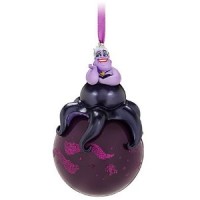 52d. [Sea witch in “The Little Mermaid”] – URSULA. I saw a cool Ursula ornament at the Disney Store. I was going to buy it for my niece, but then the Pocahontas lady started creeping me out, and I just wanted to get out of there as quickly as possible.
52d. [Sea witch in “The Little Mermaid”] – URSULA. I saw a cool Ursula ornament at the Disney Store. I was going to buy it for my niece, but then the Pocahontas lady started creeping me out, and I just wanted to get out of there as quickly as possible.- 97d. [Web image-viewing software] – PICASA. I like this one too. Take note: the alternating consonants and vowels make this name very constructor-friendly, so you’re going to see it again. Wikipedia tells me that Picasa “is a blend of the name of Spanish painter Pablo Picasso, the phrase ‘mi casa’ for ‘my house,’ and ‘pic’ for pictures.”
Quite an enjoyable theme today. Rating: 4.25 stars.
Merl Reagle’s syndicated crossword, “The Whole Nine YD’s”
No funky wordplay to figure out here, just a collection of phrases with Y.D. initials in a fairly easy crossword:
- 23a. [Payouts to stockholders] = YEARLY DIVIDENDS.
- 35a. [Marriage agreement?] = “YES, DEAR.”
- 42a. [Revolutionary song] = YANKEE DOODLE.
- 49a. [Anti-union, as some labor contracts] = YELLOW DOG. Didn’t know that one off the top of my head.
- 67a. [Sweet somethings?] = YUMMY DESSERTS. I like yummy desserts as much as anyone, but I wouldn’t call “yummy desserts” the sort of phrase that makes sense as a dictionary-grade crossword answer. And what a rip-off to have BATEAU sitting on top of it, when the French word for cake (gateau) is only one letter off. Bring me cake!
- 82a. [“Leave me out of this”] = “YOU DECIDE.”
- 89a. [1961 Fredric March-Ben Gazzara-Dick Clark drama, with “The”] = YOUNG DOCTORS. Before my time.
- 100a. Color before weaving] = YARN-DYE. Makes for a nicer stripe or plaid than mere printed designs.
- 111a. [December sights] = YULE DECORATIONS. Timely.
As I said, generally an easy puzzle. I couldn’t for the life of me make sense of 39a: [Major’s follower] until I had three or four letters via crossings. BLAIR! As in Tony Blair, John Major’s successor as British P.M. I was thinking of “words that follow major in two-word phrases.”
Why on earth did I want 65d: [___ crumbles] to be TOFU rather than OREO? I’ve heard of “tofu scramble,” not “tofu crumble.” TOFU just had to bide its time until the very next clue, 66d: [Vegan’s staple]. I must’ve subconsciously registered the second clue without thinking.
My vote for worst answer in the puzzle goes to 52d: [Scoreless tie]. OTOO means “0 to 0” with zeroes in place of two O’s. 00f!
Three stars.
Updated Sunday morning:
Tony Orbach’s CrosSynergy/Washington Post crossword, “Sunday Challenge” – Sam Donaldson’s review
Today’s Sunday Challenge is a 70/34 freestyle from Tony Orbach, a guy who normally constructs themed puzzles. It’s an olio of awesomeness and stuff that made me feel stupid. The grid is anchored by the four crossing 15s, all of which are superb. There’s BACK TO SQUARE ONE on top, NOT SOLD IN STORES along the bottom, and ALL KIDDING ASIDE along with I’M TERRIBLY SORRY providing support along the sides.
I didn’t like seeing both LT. GEN. and ASST. D.A. in the grid. One longer abbreviation is perfectly fine, but two starts to look like a compromise. But to the extent both abbreviations were needed to make YOUNG TURK, EMOLLIENT, and IT’S OK, then maybe…well…it’s ok. ASK HER OUT, however, seems both cute and arbitrary, so I can’t decide whether I like it.
The puzzle had a lot of stuff that was well outside my wheelhouse, and these entries had an annoying tendency to be clustered together. Take the far north section, for example, with NUIT, CINQ, and ATTU all crossing or beside each other. Not remembering the latter is my fault (we see it often enough in crosswords that it should be sticking with me by now), but the other two just feel sub-optimal. In the northeast, I had never met MOIRA, the answer to [Ballerina Shearer], and she rests near another stranger, EGON, the first name of [Austrian Expressionist Schiele]. In the south, all I can say is “Thank goodness I’m a golf fan,” because if I didn’t know ISAO Aoki, I’d have been even more hard-pressed to crack into that section. It boasts the full name NKGB and one [Jeanne] D’ARC, heretofore known to me only as Joan of Arc. The other unknowns to me (HESS, the [Oil magnate and former owner of the New York Jets], Italy’s Lake GARDA, and ABYSM–I thought there was only an ABYSS) were much easier to suss out given the fairer crossings.
My favorite pair of clues were the consecutive [Three, at Roland-Garros] and [Tie, at Wimbledon], for TROIS and DEUCE, respectively. I’m an ace with tennis clues!
Mike Shenk’s Washington Post crossword, “Post Puzzler No. 88”
I solved this puzzle last night but found I was too tired to blog it then. This morning? The crossword’s not so fresh in my mind. What’s in this 68-worder of moderate (between a Friday and Saturday NYT) difficulty? These 16 items, for starters:
- 1a. [His presidential palace is located on al-Rashid Street] clues Syria’s ASSAD.
- 16a. [Cartoonist who illustrated more than 100 New Yorker covers] is PETER ARNO. I like full names in a crossword, but this guy? I know him from crossword clues for ARNO.
- 18a. [One end of the rubber band in the game Operation] is the ANKLEBONE. I forget where the other is. The knee?
- 27a. [People of note?] are MELODISTS. I can’t say for sure that I knew that was a word.
- 33a. The [High achiever] who’s a STONER may achieve a high via bong, joint, or pipe.
- 45a. [He debuted in 1934’s “Fer-de-Lance”] is NERO WOLFE. Fictional full name this time and again, a name I know primarily from crossword contexts (NERO shows up a lot).
- 47a. [“The sea supplies all my wants” speaker] is NEMO. Doesn’t sound like the Pixar clownfish, so I’m guessing this is Captain Nemo.
- 54a. [According to its jingle, it’s “really neat” and “fun to eat”] clues BEEFARONI. This word always makes me think of the Seinfeld episode with the horse-drawn carriage. Kramer got a deal on giant cans of “Beefareeno” and fed it to his horse, who susbsequently had massively stinky gas.
- 56a. [It featured a Teletouch shifter] clues the EDSEL. EDSEL has been in so many crosswords for so long, I know all sorts of trivial information about it.
- 2d. [Checkers and more] refers to SPANIELS. I forget which president’s spaniel was named Checkers. Nixon?
- 3d. [Spot for setting a land speed record] is a singular SALT FLAT. I’ve only seen the plural salt flats. I’m not sure you can parcel out a chunk of an area called salt flats and identify it as a single SALT FLAT.
- 7d. [Ones who capitalize letters?] are TENANTS, “letters” being the landlords who let/lease apartments. I’ve never found this double meaning of “letter” to be entertaining. Who calls their landlord a “letter,” anyway?
- 8d. Mr. [Bean creator], Rowan ATKINSON.
- 24d. [Question and answer in a 1939 film] is “TOTO, TOO?” I’ve seen this in crosswords a few times. Is it truly a key line in The Wizard of Oz, or has it just been added to a lot of constructors’ word lists because they like the letter combos?
- 28d. DENIM is a [Blue Crayola color]. That’s a gimme for me because I was just using crayons the other day.
- 48d. [Gob stopper?] clues the legendary SIREN, “gob” meaning “sailor” here. Eh.
Nothing in the grid particularly delighted me this week. 3.25 stars.
Mike Selinker’s New York Times Second Sunday puzzle, “Diagramless”
Usually the NYT diagramlesses have 17×17 grids but this one’s smaller and thus quicker to solve. The left/right symmetry means that if 1-Across and 4-Across are different lengths, they appear centered, one above the other. This made it easier to just start filling in things in the grid, rather than sketching out my crossings in the page margins and transferring the letters to the grid later.
The grid forms the shape of a dreidel, and six theme entries aptly contain the word TOP (but not in “spinning top” contexts). The “w”-ish shape in the middle of the grid represents the Hebrew letter shin, which appears on one side of a dreidel.
I like the inter-holiday play of having a Christmas TREE TOPPER inside the Hanukkah dreidel. Four stars—one for each side of a dreidel.
Don’t miss Deb Amlen’s interview with Mike Selinker at Wordplay. He’s an entertaining guy with tons of puzzle cred outside the world of standard crosswords.
Henry Hook’s Sunday crossword, “Confusable Names” — pannonica’s review
Pairs of ostensibly confusable names comprise the theme entries here.
-
- 17a. [“Cash Cab” host] BEN BAILEY. Having only seen parts of the show once or twice, I wonder if he’s famous enough.
- 118a. [Ousted hubby of song who’s not 17-Across] BILL BAILEY. “(Won’t You Come Home) Bill Bailey“, published 1902, recorded many times.
-
- 19a. [“The French Connection” author] ROBIN MOORE.
- 116a. [HLN anchor who’s not 19-Across] ROBIN MEADE. Who? What? Oh, Headline News, okay. I’d be more likely to confuse the author with actor Roger Moore.
-
- 22a. [Radio host/ESPN alumnus] DAN PATRICK. That’s three marginal cable personalities in the first three pairs of names. I say marginal with a caveat because I don’t watch much television.
- 73a. [Auto racer who’s not 22-Across] DANICA PATRICK.
-
- 23a. [Impressionist extraordinaire] RICH LITTLE. I don’t think his paintings are that good.
- 59a. [Rock ‘n’ Roll great who’s not 23-Across] LITTLE RICHARD.
-
- 36a. [She had the title role in “Laura”] GENE TIERNEY.
- 67a. [Boxer who’s not 36-Across] GENE TUNNEY. This was my favorite of the seven theme pairs.
-
- 68a. [“Dave” star] KEVIN KLINE.
- 96a. [Designer who’s not 68-Across] CALVIN KLEIN.
-
- 113a. [1950’s pinup queen] BETTIE PAGE.
- 119a. [1950’s pop singer who’s not 113-Across] PATTI PAGE.
Seems like a mix of names that might actually be confused with each other, and names that may be confused only fantastically or academically (how odd, that I found a way to equate those two). On the other hand, who’s to say how things become muddled? Off the top of my head, I can think of a few names I confused when I was young: Chuck Berry/Chuck Barris, John Lennon/Jack Lemmon, Billie Holiday/Buddy Holly.
A very impressive aspect of the construction is the preponderance of paired, stacked theme entries: Rows Two and Three complete; Rows Nineteen and Twenty complete; Rows Ten, Eleven and Twelve offset (with Eleven complete). I suppose it would have been preferable to have the names polarized, with all of the first halves of the pairs in the top of the grid, as opposed to just most of them. I’m sure that would have been exponentially more difficult to construct.
Overall the ballast fill is good, but not great. Along with some highlights (got to love ASTARTE), there are a number of awkward plurals (neighbors WIIS and EEKS, anyone?), some hoary crosswordese (I’m looking at you, TAW), unwelcome abbrevs. (e.g., CERT.), and partials (hello, DULL AS, A BARN). For that last, however, I did smile at (44d) ITCHY AND.
New words for me: 76a [Smooth sheer fabric] NINON, which is usually made from silk or rayon or nylon (m-w says “probably from French Ninon, nickname for Anne. First Known Use: 1911″). 7d [Sinful] PECCANT; I wonder if it shares a root with peccadillo… yes, they both derive from the Latin peccare, to stumble, sin.
Finally, I was stymied for a while in the southwest corner, where [Work meas.] _TL_ connected [Charity espoused by Elizabeth Taylor] AM_AR and [Hedge-fund whiz] AR_. It took quite some time for foot-pound to bubble to the surface; the acrosses remained obscure. amfAR is the Foundation for AIDS Research (still not sure where the “am” comes from, American?), and I’m arb. is short for arbitrageur, one who is proficient in arbitrage.
I’d call this one average, but put my thumb on the scale a little for the clustering of the theme entries.
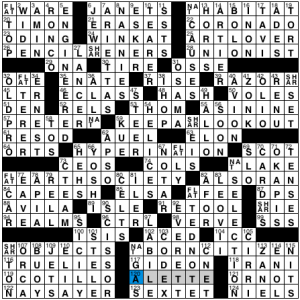
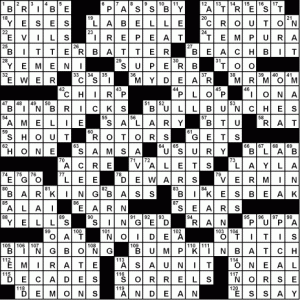
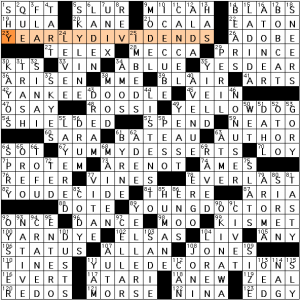
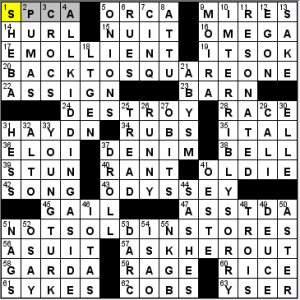
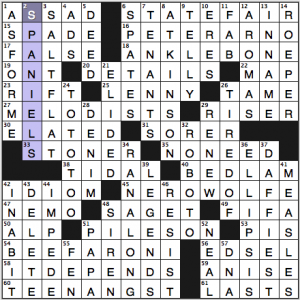
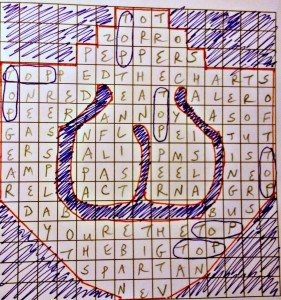
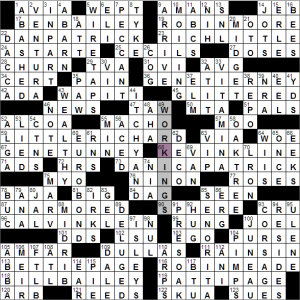
Today’s NYT – yawn
I don’t mind a musical theme, but I was thrown off a lot by the non-symmetrical placement of the rebus squares
I believe a flatted note is a note that is not necessarily a flat, but sounds relatively flat because it’s a half-step away from the previous note in the scale. In the case of F major, though, the one flatted note actually is a flat. ‘Flatted note’ doesn’t show up much on google, so I can’t verify it; hopefully someone more musically-inclined will chime in.
Either way, I don’t like that it appears in the puzzle without reference to the musical theme; none of the other rebus entries related to music, so it feels out of place.
2.75 stars seems a bit harsh. As a hackneyed musician, I liked this much more than you did… probably because I got the theme right away at PENCIL[SHARP]ENERS/JEW[SHARP], and was expecting FLAT to appear, but the NATURALs took me a while to notice.
Groaned at some of the crosswordese (most memorably at ENOL, though there were others), but it didn’t dampen my enthusiasm for the search and destroy mission.
Threw in GORE at 106-D not even thinking to fact-check it in my memory, and was deliciously surprised to realize that I’d been had.
A game of letter roulette at the ALETTE/LABILE crossing was the not-so-satisfying finish. But, overall, a fun puzzling puzzle. I gave it 4 stars; docked it mainly for that last crossing and the questionable variant spelling of “capiche”.
What about “KUE” for the letter “Q”. Couldn’t find it in any of my dictionaries. Is this a Scrabble word???
Also, didn’t like the spelling of “Capeesh”, although I don’t know how else you would transliterate this fractured Italian word.
Figured the theme out PDQ at JEW[SHARP] and confirmed it by putting in 12A without crossers – felt pretty hardcore at the moment, sorting the bottom-right brought me back down to earth. Confidently dropped in speciaTION off the TION instead of [NATURAL]SELECTION – completely fouled that section up. Ended in bottom-left – finding that rebus square was tough. SHARPOBJECTS – what an answer, ditto [FLAT]EARTHSOCIETY (http://www.youtube.com/watch?v=i-We8ogMQ-U)! CNET seems to be appearing an awful lot in the last month or so… I never get the hate for ENOL, perfectly valid bit of organic chemistry really… Slightly more crossword-friendly letters than CARBOXYL though!
ARTIER crossing ARTLOVER: Art to a T? Tsk.
LAT: They’re mother and son? Cool! Liked the title, and the first answer was SUPERB! Also: BUMPKINBATCH, though any BUMPKIN will tell you a steer is no BULL, it’s been a bit… altered. Winced writing that in. Ditto, thinking about Orbison, had RO… and thought no way can that be ROYORB?!
While there was a lot of old-skool xwordese in there, which took away from the solving a bit, I enjoyed the rebus search for the musical terms. Upon finding the first FLAT and NATURAL, I knew what to look for; uncovering the other rebus squares, while not knowing exactly where to find them, was actually the most enjoyable aspect of the puzzle. Oh, and the crazy CAPEESH.
Loved the NYT–one of my favorite Sundays in a long time. Liked the gimmick, and I though the fill was interesting.
You’re overanalyzing “one flatted note”. It’s a slightly odd locution, but the F Major scale has one flat–B flat. It doesn’t “sound flat” or anything of the sort. It’s just a diatonic scale starting on the note F. Diatonic major scales have a half-step between the third and fourth and seventh and eighth degrees of the scale and whole steps everywhere else. Depending on where you start, one or more of the tones may be a sharp or flat, (black keys on the piano.) Other scales and modes are defined by a different distribution of the half steps.
It’s very easy to figure out how many sharps or flats any scale has. Start with C Major, which has no sharps or flats, and follow the Circle of Fifths. Go up a fifth for scales with sharps. G Major–one sharp; up a fifth–D Major, two sharps; up a fifth A Major–3 sharps, etc. For major scales with flats, go down a fifth from C–F Major, one flat; down another fifth, B flat Major, two flats; down another fifth–E flat Major, 3 flats, etc. The relative minors (i.e. the scales with the same number of sharps or flats as the corresponding major keys) are a minor third lower than the relative major, e.g. the relative minor of C Major is A minor–(no sharps or flats).
At least this puzzle didn’t ask for the damn SECOND place finisher on a %^%#$(^& American Idol show, like a recent puzzle. I won’t name the culprit constructor. That made me so apoplectic I started screaming.
Still can’t get the LAT, but–all life is struggle. :-)
Bruce
In my experience “capiche” is pronounced “k’peatch”, like the fruit, but with more emphasis on the “sh” than the the “ch”.
I can accept the variant spelling, but I’m too old to like it.
Just out of curiosity, for those who solve online, I wonder if the program would accept the symbols for sharp, flat and natural, if your computer has them.
Bruce
I actually typed the regular # mark from the three key in for sharp, but it didn’t seem to like that.
I thought there was way, way too much odd fill, like ALETTE, ESKER, and ERNEST clued as it was. But I like rebus puzzles, so that kept me going.
Yes, managed to vaguely remember ESKER but ALETTE was news to me
Amy,
I followed your instructions for Peter Gordon’s puzzle but never found the link that says “Download Crossword for Across Lite.” The options I found are:
Play online: click here or on the puzzle below.
To see the solution: click here.
To print the puzzle: click here.
To see the crossword archives: click here.
They appear above the puzzle.
What’s up with that?
@ Papa John
Click the “here” link to play the puzzle online. When the Java Applet opens, under the puzzle is the link to the across lite version. Hope that helps.
Bob Klahn suggested the title for the LAT, and thank goodness, because we couldn’t come up with anything on our own.
Thanks for the write-up, Doug!
LAT: It may be helpful to remember that the Roy Orbison song is “Oh, Pretty Woman.”
Thanks, Bruce. That did the trick. I’m not sure I’ll be able to remember how to access it, again, next week.
Sure would be nice if one of the generous sites that offer .puz downloads would include this one in their selection, so it wouldn’t be such a convoluted path. (Hint, hint.)
BTW, I got a massage saying the download was using an earlier version of Java and asked me if I wanted to continue. That seemd a bit weird, to me.
CS: I enjoyed Tony Orbach’s “Sunday Challenge” a lot. The 15-letter crossings were all in-the-language smooth and interesting. And there was plenty of stand-out fill such as EMOLLIENT, ABYSM, ODYSSEY, and YOUNG TURK. I do think that “Like sunnyside up eggs” (26D) isn’t necessarily RUNNY. Just cook ’em a little longer. They’ll still be sunnyside up.
The crosswordy stuff was in my wheelhouse and was a hand up in the solve. Wake me from a deep sleep at 4 a.m. and I can instantly tell you that 54D “Golfer Aoki” is ISAO. That vowel-consonant-vowel-vowel combo is just too handy for constructors and we ain’t seen the last of it, fer sure. (Wonder why we never see the equally handy ANOA?)
This is the kind of puzzle that got me interested in crosswords years ago and keeps me coming back for more. Thanks Mr. Orbach.
Flatted note –usually one which is not in the key signature (as the B is, in the key of F major) but gets its own flat sign within a particular measure when needed. A simple example would be in the opening notes of “O Little Town of Bethlehem” in the key of C, where the first three notes are E and then you have an E-flat for the fouth, on “Town.”
@Papa John: I got it from the direct link here: http://www.crosswordfiend.com/blog/download/
p.s. sorry, I misspelled “fourth”, on “Town.” Not so simple an example? Actually, that’s more likely to be written as a D-sharp, so that the next E would not need a natural sign to undo the flat…. The point is that the key of C major has no sharps or flats in the key signature, so any black notes must be indicated separately as they occur.
Thank you for your comments, everybody. In case anyone’s interested I posted a really long background piece on the puzzle at Rex Parker. If you happen to solve on the applet I’m tjpoli on there. Really original, I know. Thank you again!
Congrats, Tim — I loved your debut puzzle, and many thanks for the many details on its Evolution over at Rex’s blog. It makes one appreciate the finished product even more!
I thought the NYT might have been the best puzzle of the year – I was quite surprised to read how it rubbed Amy rather negatively. The trick popped out at me unusually early in the game, and other than some considerable obscura (alette!) and mistakenly thinking there were seven players on a hockey team (thus SESTET) it made for a fine solving experience.
Art
Anoa Bob,
Thanks for the kind words – glad you liked the “Sunday Challenge” and that the sticky wickets were in your wheelhouse (maybe there’s a theme somewhere in combining cricket and baseball idioms?).
So, how’s your golf game? Keep practicing and some day we could see [Golfer Bob] for the you-know-which vowel-consonant-vowel-vowel entry.
Also, congrats to Tim – a debut rebus Sunday NYT is pretty impressive.
I am with the pluses here. The NYT puzzle may have taken me forever, but I was never bored. I liked it better than many other Sunday NYT puzzles and certainly better than last week’s which I found a real slog.
ArtLvr–You’re right, of course that the fourth chord (and 1st chord change) in O Little Town should be (not “would probably be”) spelled as a D#, not an E flat, but for much more subtle harmonic reasons than merely “so you don’t have to write a natural the next time an E appears.” The point is that the underlying harmony demands it. On the word “town”, the tonic C remains in the bass, and the alto and soprano would be spelled as a major sixth, F# and D# respectively, since those tones are functioning as non-chord tones heard as resolving upward, back to the G – E tonic chord. Then the beautiful change on the first syllable of BETH -le-hem–the bass jumps a fourth to an F, and the entire chord would be spelled F, C#, A, G. For an even more harmonic poignancy, you could play a B flat in the alto, instead of an A. That would be a B flat, not an A #, since the harmonic activity of the chord is for the C# in the tenor to resolve upward to a D, and the B flat in the alto to resolve downward to an A, and the G to resolve downward to an F, yielding a chord on the 2nd syllable of beth LE spelled F, D, A, F, or a D minor chord (a “II” chord) with the third in the bass, (I.e. what is called a II 6 chord. (Then the piece moves to a “I 6/4 chord–a C chord with the G in the bass to a V 7 (a G dominant 7th chord), and so forth. The point of all this is that in tonal music, the spelling of the chords is not just done out of arbitrary convenience, but is fairly strictly determined (though not always *absolutely* determined) by harmonic context.
Bruce